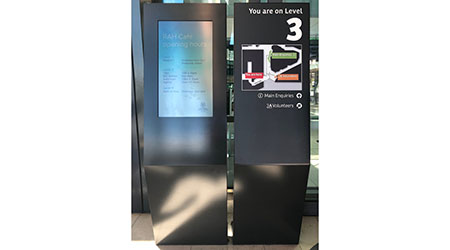In the COVID-19 era, healthcare facilities face an entirely new array of challenges involving the way employees work and keep patients safe. With logistical issues within these facilities ranging from room booking to contact tracing efforts, healthcare managers have a lot to juggle while maintaining operations to support both COVID and non-COVID related illnesses and treatment.
In order to continue prioritizing the best possible patient care while adhering to new CDC regulations, including social distancing and health screenings, it’s critical to find ways to adapt and overcome these challenges in a way that promotes public health and operational continuity. Here, we’ll dive into some of the most pressing barriers for health-centric operations, and look into some examples of how digital signage and wayfinding technology can help mitigate the risks and keep healthcare facilities – hospitals, offices, diagnostics labs, and more – running smoothly.
Identifying the pain points
When it comes to running a healthcare facility, especially during the COVID-19 pandemic, the single most important consideration for employees, patients and managers alike is public health. The pandemic introduced a plethora of new considerations for wellness, protection, and guideline enforcement, including temperature checks, social distancing regulations, and communication plans for relaying critical updates on viral spread. On top of this, CDC and internal organizational guidelines are subject to change at any time as infection rates fluctuate and new discoveries come to fruition. This has created a need for constant communication and strict guideline adherence to ensure the lowest risk possible within health care facilities.
As the pandemic accelerated, many healthcare providers transitioned to telehealth and remote patient care models. Now, as most healthcare facilities have re-opened to the public, there have been increasing discussion about ways to reduce physical touchpoints and keep both patients and staff safe.
Facility managers worldwide faced a scramble of planning – including plans for implementing new temperature check protocols, screening processes, and logistical adjustments associated with social distancing. Prior to the pandemic, healthcare providers did not anticipate these stark adjustments, and as a result needed to begin planning protocols from scratch, with just national and state guidelines to steer them in the right direction.
Luckily, digital signage and wayfinding software has developed as quickly as the guidelines have, offering options never-before-available to healthcare facilities worldwide. Solutions introduced by digital signage and wayfinding. When it comes to keeping your healthcare facility safe and running smoothly, digital signage and wayfinding solutions can help -- by implementing technologies such as access control, interactive wayfinding, and temperature checks via thermal scanning, signage systems can provide access and flow control, maintaining a safe work environment and a safe route for visitors to their destinations.
An increasingly popular implementation of interactive wayfinding is via touch-free kiosks, which can be positioned at an entrance or reception desk as the first line of defense against viral spread. These kiosks, depending on the facility’s need, can serve a variety of purposes with an abundance of features complete with automatic voice control prompts to reduce touchpoints on the device, or accessibility to maps and other communications via a QR code on a smartphone.
The capabilities of these devices can range from temperature checks via built-in thermal scanning technology, to emergency alerts and updated news on facility policies, and to instructions for safely navigating the facility to adhere to social distancing. In addition to the kiosk at the entry, additional interactive wayfinding throughout a facility supports scheduled navigation to control traffic pathways and flow around the building, regulating available spaces and pre-approved routes to reduce wandering and support social distancing. All these features can be managed remotely by IT, human resource teams, or facility management teams for optimal convenience and safety.
Another feature that wayfinding technologies can introduce to healthcare facilities to support building management post-COVID is hot-desking and room scheduling software. Hot-desking and scheduling systems leverage a combination of sensors and digital signage to block spaces, rooms, and offices that maintain a safe social distance from other occupants, while also marking which areas are occupied to need to be cleaned before a new occupant enters the space. This integrated solution, combining sensors, visual communications, signage, and interactive wayfinding can assist healthcare facility managers in better understanding how spaces are being utilized and more effectively supporting informed decision-making.
Signs for the future
Digital signage and wayfinding technology bridge a gap in the communication, testing and patient care elements of the modern healthcare facility and allow providers to deliver important messages, reduce costs spent on collateral, and improve both productivity and public safety. These technologies have shifted from being a “nice to have” addition to healthcare facilities to placing a critical role in communication and navigation inside of them. As the situation surrounding public health continues to evolve and introduce new challenges, wayfinding and digital signage solutions will continue to be an integral tool for enforcing guidelines, promoting public safety, and driving overall efficiency for healthcare providers.
Kathy Isaacs is the Account Director, Healthcare at 22Miles.

 States Move Forward to Better Protect Senior Citizens
States Move Forward to Better Protect Senior Citizens Archer and REDA to Transform Newport Beach Building into Outpatient Center
Archer and REDA to Transform Newport Beach Building into Outpatient Center Sunflower Medical Group Facing Lawsuit Following January Data Breach
Sunflower Medical Group Facing Lawsuit Following January Data Breach Nemours Children's Health Opens New Location in Lake Nona
Nemours Children's Health Opens New Location in Lake Nona Enhancing Safety at Hennepin Healthcare with a Screening System
Enhancing Safety at Hennepin Healthcare with a Screening System